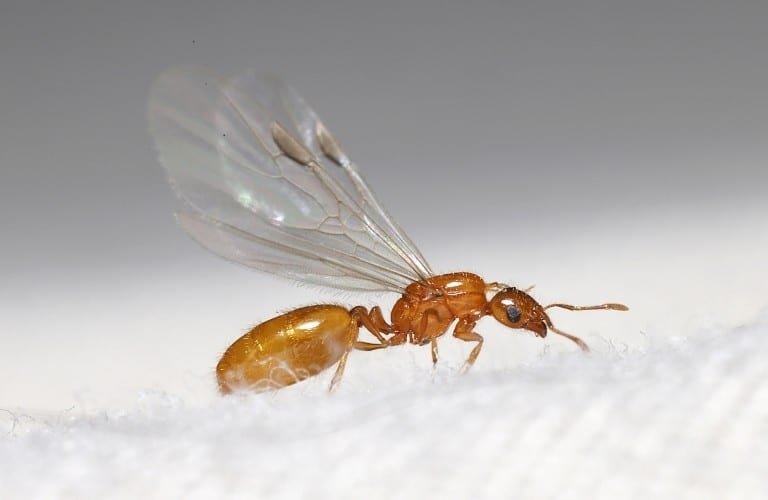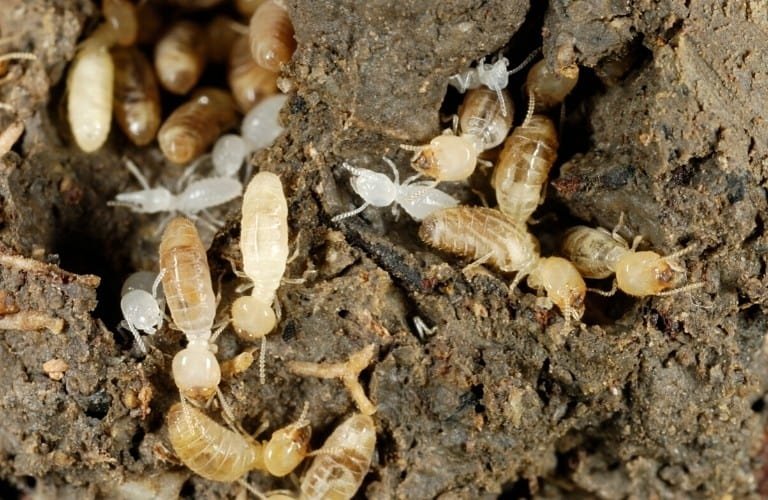Termites and flying ants are two household pests that can be easily confused.
Because both termites and flying ants have wings, antennae, and other similar features, figuring out which pest you’re dealing with can be tricky unless you are aware of the subtle differences.
What is the difference between termites vs. flying ants? Termites are destructive and have straight antennae, uniform body thickness, no discernible waist, and four long, thin wings of equal length. Flying ants are harmless and have bent antennae, three distinct body segments with a pinched waist, two long wings, and two short wings.
In the following, you will learn about the differences between termites and flying ants, how to identify them, and the signs that indicate their presence.
Keep your home safe from these destructive pests. Click here to see all of our key prevention tips and elimination techniques.
Identifying Termites
Termites are well known for their affinity for destroying wood.
You might envision that if you have termites, you’ll see heaps of sawdust piling up. (This actually may indicate a carpenter ant infestation.)
Unfortunately, it is not always that easy to identify an infestation, and you will likely need the help of a trained professional.
(Did you know that the presence of just one termite could indicate a much larger problem? Learn more here.)
Termites are quite stealthy, and you may not even notice that they are there unless a piece of wood they have been attacking is broken open.
However, if you have seen insect activity around your home, particularly in areas with wood, you’ll want to identify the pests right away.
Check with our DIY guide for home inspection to learn what to look for and where to search.
There’s no need to worry about getting too close when inspecting a possible termite nest. They rarely bite, as we explain here.
Many termites you’ll see have a creamy coloration, much different than any ants you’ll come across, though some termites are brown or black depending on what type they are and their age.
Again depending on their type and age, termites can range from 1/8 to 1 inch in length. Winged termites will have two sets of wings that are equal in size.
While termites do have three body segments, they do not have the “pinched” waist that ants do, and it may appear that they only have two distinct segments.
Another easy identification tip is to look at the antennae – termites have straight antennae and ants’ antennae are bent.
Identifying Flying Ants
Flying ants are typically found in the hot summer months and travel in swarms, ensuring their safety.
Swarms of flying ants typically contain what are known as alates – newly emerged, winged males in search of a mate. (Be sure to read our informative post on alates here.)
Flying ants can vary in size greatly, depending on species. They look just like others of their species, except, of course, for the presence of wings.
Flying ants, like termites, have two sets of wings. However, the rear wings are noticeably shorter than the front pair.
The three body sections are easily noted, and upon close examination of the antennae, you’ll see a definite bend near the base.
While they can be quite annoying, they are not destructive (unless they are carpenter ants) and will likely not cause anything more than an ant infestation in your home.
On our ant page, you’ll find clear guidelines for eliminating infestations, both indoors and out as well as interesting facts about these industrious workers.
Characteristics of Termites and Flying Ants
When trying to determine if you have flying ants or termites, you may be able to distinguish between the two by the characteristics of their bodies.
While they are similar, there are easily identifiable differences if you can get close enough to examine them.
| Body Characteristics of Termites | Body Characteristics of Flying Ants |
| A broad body | A segmented body (pinched in the waist) |
| Four wings – long, thin, and equal in size | Four wings – large wings in the front, small in the back |
| Straight antennae | Bent antennae |
Signs You Have Termites
Perhaps you are not the best at determining what type of bug infestation you are dealing with based on the body features.
There are some other indicators that you may be dealing with termites. Experts often look for:
- Broken insect wings.
- Mud tubes.
- Damage.
- Swollen wall and floor panels.
- Peeling and bubbling paint.
- Hollowed-out wood.
- Clicking noises.
- The presence of bugs.
- Termite droppings.
- Loose floor tiles.
- Swarms of termites.
Broken Insect Wings
It is very common to see piles of broken insect wings when there is a termite infestation.
Termites travel in swarms, and when they find a suitable location to build a nest, they drop their wings.
You will likely not see termites near the wings; however, you can rest assured there is probably a nest nearby.
Mud Tubes
Subterranean termites build structures called mud tubes.
The mud tubes are tunnels the termites use to travel around their nests and typically appear outside of a structure but can also occur inside.
Outdoor Damage
Termites feed on wood, so trees around your home could be host to termite colonies without you knowing.
Small holes in trees and wings and/or holes around the base of the tree can indicate a termite infestation.
While not directly affecting your home, it can cause the tree to become unstable.
Swollen Wall and Floor Panels
When there are termites in your home, you may notice bulges in your floor or wall.
This can be an indicator that termites have been moving and making nests in these areas.
These changes will likely not occur quickly, so there is a good chance they have settled in already if you notice this.
Peeling and Bubbling Paint
Although termites do not eat paint, they allow moisture to get under the paint when they’re eating through the wood.
The excess moisture is responsible for the bubbling and sometimes peeling paint.
Hollowed-Out Wood
A strong characteristic of a termite infestation is hollowed-out wood. Termites eat tunnels through wood sources until they are hollow shells.
This is often the cause of structures crumbling.
Clicking Noises
When there is a termite infestation, it is common to hear clicking noises coming from the walls or the nest location.
Some refer to this as head banging because that is what the termites are doing inside the tunnels to warn the colony.
Loose Floor Tiles
If the termites have created nests under the floorboards of your home, there is a chance that moisture has entered and caused the tiles to loosen from the floor.
Termite Droppings
Like any insect infestation, you will find evidence of their presence by seeing the droppings left behind.
If you see a lot of termite droppings, there is likely a nest nearby. Look for sawdust-colored granules similar to coffee grounds.
Swarms
One of the most likely indicators you have a termite problem is when you see swarms of the insects buzzing around.
Insects swarm before finding a proper nesting location, so it is not likely that you will frequently see swarms of termites.
You may see other signs of termites around your home, but they may not be obvious until significant damage has occurred.
If you think there is even a small chance that you have termites, it would be wise to seek an expert’s advice.
In our article “How To Get Rid of Termites,” you’ll learn the best ways to prevent termite damage and both natural and chemical methods to eradicate them from your property.
Signs You Have Flying Ants
These key indicators can identify flying ants: sawdust under an already damaged wood source and swarms.
Sawdust
When you have a colony of flying carpenter ants, you may notice sawdust laying around.
It is important to remember that ants do not eat wood. They will, however, chew through it while excavating tunnels and cast the resulting sawdust aside.
Swarms
Flying ants travel in swarms, just as termites do.
However, flying ants are not searching for a location to destroy; they are looking for reproduction opportunities.
Flying ants are also seasonal. You will often see flying ants during the hot summer months.
Flying ants are not problematic, apart from the annoyance swarms can cause when they appear during the warm months of summer.
However, it would be wise to find an expert to help stop an infestation from occurring, especially if it is a carpenter ant swarm.
How Do You Eliminate Termites and Flying Ants?
The elimination of termites is likely not something you can handle independently.
Because termite infestations can cause significant damage, you need to make sure they are eliminated completely soon after discovering them.
Sometimes you can eliminate termites by applying insecticide specifically formulated for termites around the outside of your home.
Installing detection/killing stakes can help too as they will alert you to termite activity and kill any foraging termites.
Be sure to head over to this article to see which bait stations would be efficient for your home and to learn about other DIY treatment options.
If structural damage has already occurred, you will likely need to call in the help of a professional exterminator.
Flying ants are easier to eliminate.
You can vacuum a swarm of ants up quickly, or you can use an insect spray, like this one for indoor and outdoor use, to eradicate the swarm on contact.
Final Thoughts
Both termites and flying ants can be household pests that need to be dealt with accordingly.
If you are uncertain about which pest is inhabiting your home, you will likely want to call an expert to advise you with the next steps.
If termites are not taken care of properly, they can cause a lot of damage to your home, so do not delay in taking action.
Sources:
- https://citybugs.tamu.edu/factsheets/household/termites/ent-6002/
- https://www.natgeokids.com/za/discover/animals/insects/flying-ants/
- https://www.terminix.com/termite-control/identification/what-does-a-termite-look-like/
- https://www.bigbluebug.com/blog/post/when-do-termite-swarmers-lose-their-wings
- https://www.terminix.com/blog/education/termite-structures-101-what-is-a-mud-tube/
- https://www.advancedpestcontrol.com.au/the-top-5-signs-you-have-termites-in-your-home/
- https://www.orkin.com/termites/facts/do-termites-make-noise-in-walls
- https://thepestrangers.com/do-you-recognize-the-7-early-warning-signs-of-a-termite-infestation/
- https://www.callnorthwest.com/2018/03/swarm-insects-termites-flying-ants/
- https://thebugskiller.com/how-to-kill-termites-and-get-rid-of-them-forever/








